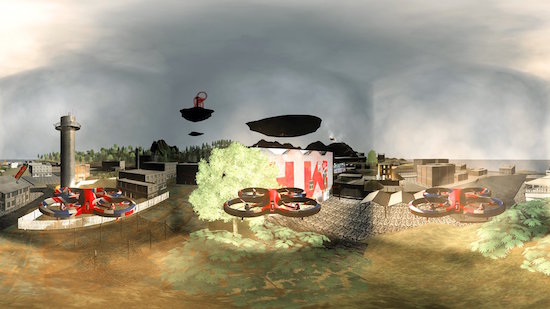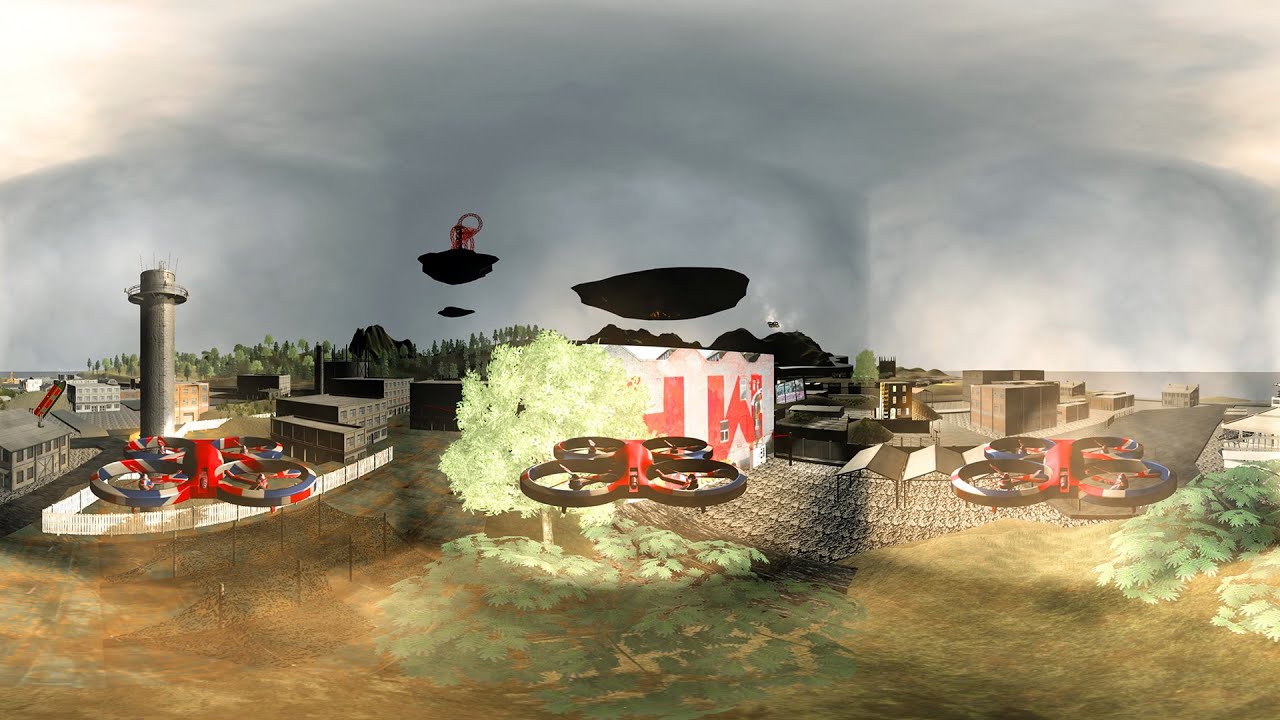In 1977, Sol LeWitt cut out a triangle of a London A-Z with, at its three corners, the Lisson Gallery, off the Edgware Road, the Nigel Greenwood Gallery, in Chelsea, and the Tate (now Tate Britain) at Millbank. Now considered a seminal work of conceptual art itself (and included, recently, in the Tate’s own Conceptual Art in Britain survey), LeWitt’s triangle also served to map out what the artist considered to be the three cardinal points in London’s conceptual art scene at the time.
Over the last three years, Lawrence Lek has been building his own map of British art nodes. His Bonus Levels take the form of virtual 3D worlds on a screen that the viewer navigates through with the help of a video game controller. These game worlds have given gallery-goers the chance to explore futuristic visions of the Royal Academy, the Parasol Unit, and Dalston’s Gillett Square after global warming and any number of other dystopian catastrophes have left them ruined, isolated, and permanently scarred by histories that have not yet taken place.
The latest iteration, Overseas 海外 [Delirious New Wick 360° Video Edition], part of a project for London-based curatorial platform, Up Projects, revisits an earlier Bonus Level from 2012 set in a re-wilded Hackney Wick, now newly updated in the light of the EU referendum result.
"The way I work sometimes," Lek explains, "making these virtual worlds, I update them as time goes on, reflecting on different changes that have taken place. So in a way they become continuous strange documentaries of the places I’m based in. My studio is in the White Building, so it’s literally in the middle of all of those changes. I thought it was a good starting point to think about how the city keeps on transforming."

I met Lek in a cafe in Victoria Park. I was late. And I made myself even later in what would strike me later as a peculiarly apposite manner. Being not-all-that familiar with that particular cafe in that particular park, I was relying on the map app on my phone to guide me from one end of the park to the place of our appointment. Somehow, eyes down, following intently the thick blue line on my screen, I only succeeded in getting more lost, finally ending up at completely the opposite end of the park to where I was supposed to be. I had mistaken the map for the territory, the virtual world for its real life counterpart, and now here I was, sweaty, exhausted, miles from where I was supposed to be, generally screwed.
"Originally [the Bonus Levels] were very loose critiques of neo-liberal regeneration and specifically, culturally-led gentrification – like where we’re sitting right now," Lek explained when I finally found him, at a picnic table, doodling peaceably in his sketchbook. "There’s a whole hypnagogic tradition of representing London, through walks and literature, through novels, music and so on. Those are just the things that I’m drawn to naturally so it finds its outlet somehow."
In an essay on Lek’s website, he describes these works as "a continuation of architecture through other means." Taking its name from the additional stages hidden with computer game worlds, he goes on to explain, video game bonus levels "create exceptional scenarios where spatial, temporal, or rule-based conventions no longer apply … By subverting the internal logic of the game engine, these zones drew attention to its underlying mechanics, after which players could return to the conventional levels with a heightened awareness of the virtual world. Bonus Levels translates this means for generating awareness from a device for virtual entertainment to one of progressive civic engagement."
A month ago, however, the project took a different turn. "I kind of came to an end point of looking at that," he says, "because what, in the end, can you really say about gentrification?" He went back to a ‘level’ from last year, Dalston, Mon Amour and revisited it, in the light of the impending referendum. "I originally re-made the Dalston one as a parody," he says, "because it was before the vote had taken place – and I didn’t think that it actually would happen. It was more just poking fun at the idea. But the fact that it did made me, I guess, reconsider a lot about myself and my status as an immigrant."
Overseas 海外 reconfigures the previous Delirious New Wick as a dark and dismal rainy fascist island, toured by a Union Jack drone copter that finally hovers through the derelict remains of a referendum polling booth, decorated with Wolfgang Tillmans’s "What Is Lost Is Lost Forever" Brexist protest posters.

"They’re very genuine," Lek says of the series of posters Tillmans created in the run up to the referendum. "There’s no sense of irony or anything like that – which is great. I kind of identify with his cultural perspective as a German living and working here quite a lot of the time."
"I was born in Frankfurt, grew up in South-East Asia, but I’ve lived in London for a really long time," he continues. "Because I’ve been travelling around quite a lot, I’m naturally drawn to the idea of place. I originally studied architecture, not because I was particularly interested in function or providing shelter, but more just the idea of place – especially nowadays when that’s much more mobile and fluid."
"In architectural design, you build the model before you build the building. There’s a weird time continuum that happens where it exists in potential and as an object of speculation. So I thought, what if you actually took that stage, that representational stage, that 3D model, artist rendering, as the final thing itself, without actually thinking about practicalities, or functionalities, or raising funds, or property development – which are things I feel cut off from because I can’t afford to buy anything."
"If you see a computer-generated rendering on a hoarding up around a building site, the rendering is always glossier than it would be in real life. But for the Olympic Park, because I’ve been in the White Building, the studio there, since just before it opened, I’ve seen that evolve from this kind of weird semi-militarised space. because across from my studio it was actually fenced off with soldiers patrolling during the Olympics. So it changed from this promise of global utopia, pre-Olympics, all of the countries of the world come together, then it was actually this fortified island between Westfield in Stratford and Hackney Wick. And then seeing it gradually open up in this planned way into public parkland. So I guess I saw the whole life cycle. It’s just been quite an interesting thing to reflect on: thinking about the utopian global promise of 2012 and, now, not even four years afterwards…"



